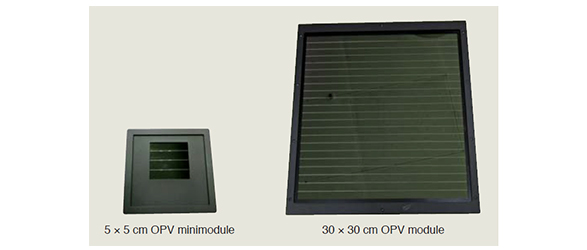- Back to the previous page
- Nano Materials & Devices
Organic Photovoltaic Cells with High Conversion Efficiency
Organic photovoltaic (OPV) cells are light in weight and flexible and can be printed in various forms.
Toshiba has developed OPVs with the world's highest conversion efficiency(*) by using an original p-type polymer and a highprecision patterning film formation method called meniscus coating. Our newly developed 20 × 20 cm OPV submodule has an efficiency of 6.8%, while our 5 × 5 cm OPV minimodule has an efficiency of 8.5%. Furthermore, we have developed a 30 × 30 cm OPV module and verified its power generation capability.
OPVs offer higher efficiency in indoor lighting environments. We have confirmed that their efficiencies under light-emitting diode (LED) illumination are higher than those of crystal- and amorphous-Si photovoltaics.
This work was partly supported by the New Energy and Industrial Technology Development Organization (NEDO), Japan.

5 × 5 cm OPV minimodule with world's highest conversion efficiency
and 30 x 30 cm OPV module
(*) Green, M.A. et al 2014. "Solar cell efficiency tables (version 43)." Progress in Photovoltaics: Research and Applications 22 (1): 1–9. (as researched by Toshiba)


